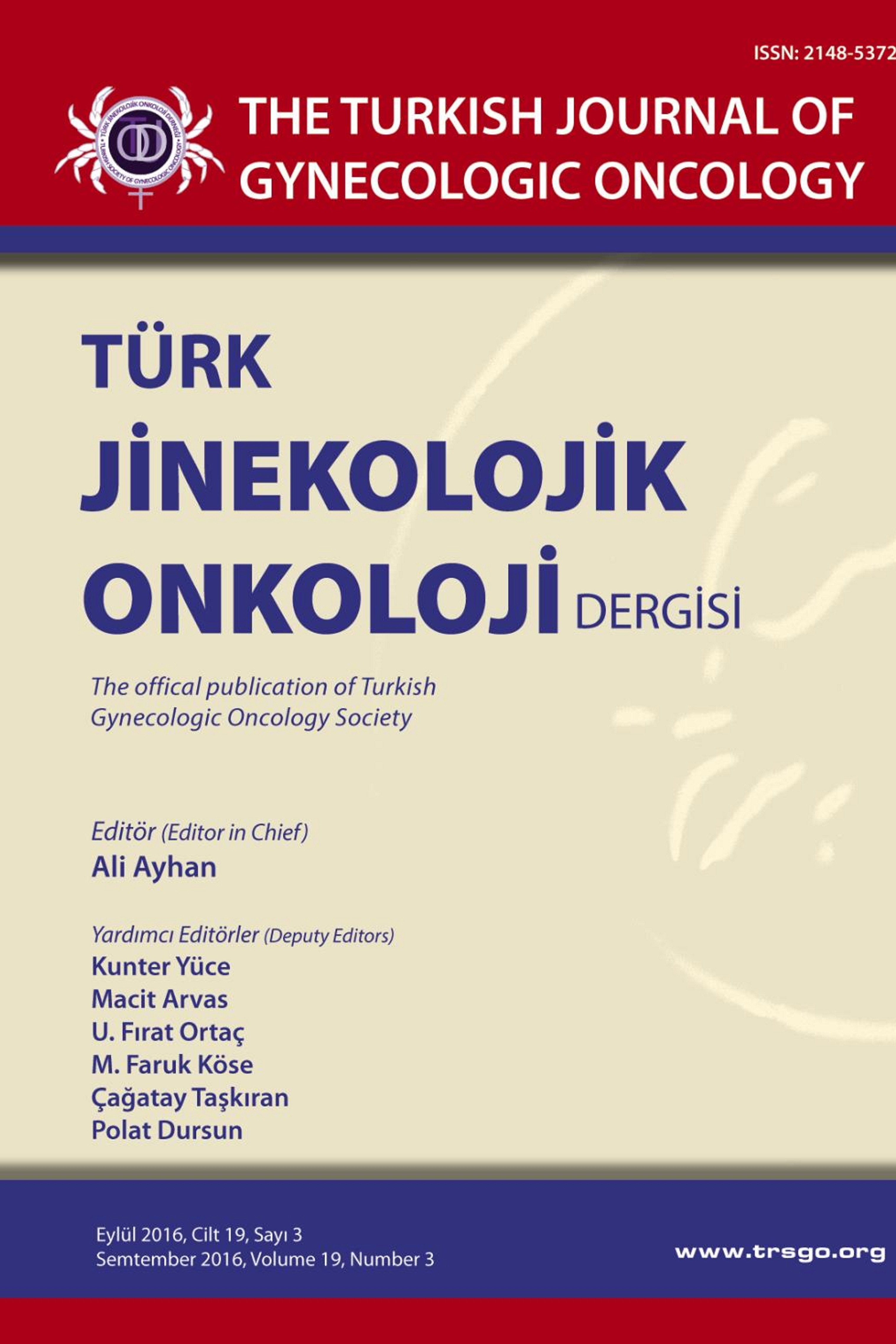LOKAL İNVAZİV VE KOMPLİKE SERVİKAL KARSİNOMLARDA PELVİK EKZANTRASYONUN ETKİNLİĞİ
Serviks Kanseri, Pelvik Ekzantrasyon, Morbidite, Mortalite.
Cervical Cancer, Pelvic Exenteration, Morbidity, Mortality,
___
- 1. DiSaia Creasman. Klinik Jinekolojik Onkoloji. Gunefl Kitabevi Ltd.fiti., Ankara 2003, s:97.
- 2. Marnitz S, Köhler C, Müller M, Behrens K, Hasenbein K, Schneider A. Indications for primary and secondary exenterations in patients with cervical cancer. Gynecol Oncol. 2006 Dec;103(3):1023-30.
- 3. Landoni F, Maneo A, Colombo A, Placa F, Milani R, Perego P, et al. Randomized study of radical surgery versus radiotherapy for stage IB-IIA cervical cancer. Lancet 1997;350:535-40.
- 4. Lai CH, Hong JH, Hsueh S, Ng KK, Chang TC, Tseng CJ, et al. Preoperative prognostic variables and the impact of postoperative adjuvant therapy on the outcomes of stage IB or II cervical carcinoma patients with or without pelvic lymph node metastases. Cancer 1999;85:1537-46.
- 5. Lai CH. Management of recurrent cervical cancer. Chang Gung Med J. 2004 Oct;27(10):711-7.
- 6. Peiretti M, Zapardiel I, Zanagnolo V, Landoni F, Morrow CP, Maggioni A. Management of recurrent cervical cancer: a review of the literature. Surg Oncol. 2012 Jun;21(2):e59-66. doi: 10.1016/j.suronc.2011.12.008.
- 7. Hacker NF. Cervical cancer. In: Berek JS and Hacker NF, eds. Practical Gynecologic Oncology, 3rd ed. Pliladelphia: Lippincott Williams & Wilkins, 2000:345-405.
- 8. Ramirez PT, Modesitt SC, Morris M, Edwards CL, Bevers MW, Wharton JT, et al. Funtional outcomes and complications of continent urinary diversions in patients with gynecologic malignancies. Gynecol Oncol 2002;85:285-91
- ISSN: 2148-5372
- Başlangıç: 2014
- Yayıncı: Türk Jinekolojik Onkoloji Derneği
Ali YAVUZCAN, Mete ÇAĞLAR, Yusuf ÜSTÜN, Serdar DİLBAZ, Seren TOPUZ, Sıtkı ÖZBİLGEÇ, İsmail ÖZDEMİR
OVER TÜMÖRLERİNDE SERUM VEGF DÜZEYİNİN DİAGNOSTİK VE PROGNOSTİK DEĞERi
Mesut MISIROĞLU, Özlem ALTINKAYA, Ebru ZÜLFİKAROĞLU, Aylin SAĞLAM, Tayfun GÜNGÖR
POSTMENOPOZAL HASTADA MALİGN GÖRÜNÜMLÜ SERVİKAL ENDOMETRİOZİS: OLGU SUNUMU
Simender MESCİ HAFTACI, Dilek BATU DEMİR
Simender MESCİ HAFTACI, Mustafa ALBAYRAK, Şerif DEMİR, Ümran YILDIRIM, Handan ANKARALI, Fatih KESKİN
LOKAL İNVAZİV VE KOMPLİKE SERVİKAL KARSİNOMLARDA PELVİK EKZANTRASYONUN ETKİNLİĞİ
Aliyeva GÜNAY AZER, Aliyev AZER RAFİQ
A RARE MASS OF THE VULVA: GIANT ENDOMETRIOMA
Burak KARADAĞ, Aşkı ELLİBEŞ KAYA
ENDOMETRİUM KANSERİNDE RADYOTERAPİ- KEMOTERAPİNİN ROLÜ: RANDOMİZE ÇALIŞMALAR EŞLİĞİNDE DEĞERLENDİRME
